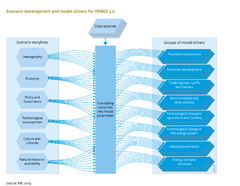Drivers: Difference between revisions
Jump to navigation
Jump to search
m (Text replace - "OECD Environmental Outlook to 2050 (2012)" to "OECD Environmental Outlook to 2050 (2012) project") |
No edit summary |
||
| Line 1: | Line 1: | ||
{{DriverComponentTemplate | {{DriverComponentTemplate | ||
|Application=Millennium Ecosystem Assessment project; OECD Environmental Outlook to 2050 (2012) project; IPCC SRES (2000) project; SSP project | |Application=Millennium Ecosystem Assessment project; OECD Environmental Outlook to 2050 (2012) project; IPCC SRES (2000) project; SSP project | ||
|Overview=Framework overview; Variable overview; | |Overview=Framework overview; Variable overview; | ||
| Line 7: | Line 6: | ||
|Description=In order for the IMAGE model to explore future scenarios, exogenous assumptions need to be made for a range of factors that shape the direction and rate of change in key model variables and results. Together with the endogenous functional relationships and endogenous model parameters that jointly typify the behaviour of the model, these exogenous assumptions drive the outcome of any particular model calculation. In other words, these assumptions are the drivers that determine the model results subject to the assumed external conditions. | |Description=In order for the IMAGE model to explore future scenarios, exogenous assumptions need to be made for a range of factors that shape the direction and rate of change in key model variables and results. Together with the endogenous functional relationships and endogenous model parameters that jointly typify the behaviour of the model, these exogenous assumptions drive the outcome of any particular model calculation. In other words, these assumptions are the drivers that determine the model results subject to the assumed external conditions. | ||
For IMAGE, six groups of assumptions are distinguished that make up the scenario drivers. These drivers are the basis of any scenario and are generally rooted in a scenario narrative or storyline. This includes cases where current trends and dynamics are assumed to continue into the future; commonly referred to as reference or ‘business-as-usual’ cases. As a rule, scenario drivers do not constitute numerical model inputs, but they do govern in qualitative or semi-quantitative terms the more elaborate set of exogenous assumptions in terms of model input files for the various parts of the model framework. In other words, numerical model drivers for any specific scenario will need to be established on the basis of the six more generic scenario drivers. The model drivers for the various modules are explained in more detail in the model components (these can be accessed via [[Framework_overview]]) . The scenario drivers and underlying narrative, together with the concrete quantitative model drivers form a scenario, inextricably linked with the results from the IMAGE scenario run. | For IMAGE, six groups of assumptions are distinguished that make up the scenario drivers: | ||
# demographics; | |||
# economics; | |||
# culture and lifestyle; | |||
# policy and governance; | |||
# natural resource availability; | |||
# technology dynamics. | |||
These drivers are the basis of any scenario and are generally rooted in a scenario narrative or storyline. This includes cases where current trends and dynamics are assumed to continue into the future; commonly referred to as reference or ‘business-as-usual’ cases. As a rule, scenario drivers do not constitute numerical model inputs, but they do govern in qualitative or semi-quantitative terms the more elaborate set of exogenous assumptions in terms of model input files for the various parts of the model framework. In other words, numerical model drivers for any specific scenario will need to be established on the basis of the six more generic scenario drivers. The model drivers for the various modules are explained in more detail in the model components (these can be accessed via [[Framework_overview]]) . The scenario drivers and underlying narrative, together with the concrete quantitative model drivers form a scenario, inextricably linked with the results from the IMAGE scenario run. | |||
|ComponentCode=D | |ComponentCode=D | ||
|FrameworkElementType=driver component | |FrameworkElementType=driver component | ||
}} | }} | ||
[[Page has default form::DriverComponentForm| ]] | [[Page has default form::DriverComponentForm| ]] | ||
Revision as of 17:46, 17 January 2014
| Projects/Applications |
| Models/Databases |
| Relevant overviews |
| Key publications |
